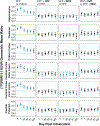A longitudinal MRI and TSPO PET-based investigation of brain region-specific neuroprotection by diazepam versus midazolam following organophosphate-induced seizures
- PMID: 38527652
- PMCID: PMC11250911
- DOI: 10.1016/j.neuropharm.2024.109918
A longitudinal MRI and TSPO PET-based investigation of brain region-specific neuroprotection by diazepam versus midazolam following organophosphate-induced seizures
Abstract
Acute poisoning with organophosphorus cholinesterase inhibitors (OPs), such as OP nerve agents and pesticides, can cause life threatening cholinergic crisis and status epilepticus (SE). Survivors often experience significant morbidity, including brain injury, acquired epilepsy, and cognitive deficits. Current medical countermeasures for acute OP poisoning include a benzodiazepine to mitigate seizures. Diazepam was long the benzodiazepine included in autoinjectors used to treat OP-induced seizures, but it is now being replaced in many guidelines by midazolam, which terminates seizures more quickly, particularly when administered intramuscularly. While a direct correlation between seizure duration and the extent of brain injury has been widely reported, there are limited data comparing the neuroprotective efficacy of diazepam versus midazolam following acute OP intoxication. To address this data gap, we used non-invasive imaging techniques to longitudinally quantify neuropathology in a rat model of acute intoxication with the OP diisopropylfluorophosphate (DFP) with and without post-exposure intervention with diazepam or midazolam. Magnetic resonance imaging (MRI) was used to monitor neuropathology and brain atrophy, while positron emission tomography (PET) with a radiotracer targeting translocator protein (TSPO) was utilized to assess neuroinflammation. Animals were scanned at 3, 7, 28, 65, 91, and 168 days post-DFP and imaging metrics were quantitated for the hippocampus, amygdala, piriform cortex, thalamus, cerebral cortex and lateral ventricles. In the DFP-intoxicated rat, neuroinflammation persisted for the duration of the study coincident with progressive atrophy and ongoing tissue remodeling. Benzodiazepines attenuated neuropathology in a region-dependent manner, but neither benzodiazepine was effective in attenuating long-term neuroinflammation as detected by TSPO PET. Diffusion MRI and TSPO PET metrics were highly correlated with seizure severity, and early MRI and PET metrics were positively correlated with long-term brain atrophy. Collectively, these results suggest that anti-seizure therapy alone is insufficient to prevent long-lasting neuroinflammation and tissue remodeling.
Keywords: Benzodiazepines; Diisopropylfluorophosphate; In vivo imaging; Neuroinflammation; Rat; Status epilepticus.
Copyright © 2024 The Authors. Published by Elsevier Ltd.. All rights reserved.
Conflict of interest statement
Declaration of competing interest The authors declare the following financial interests/personal relationships which may be considered as potential competing interests: Pamela J Lein reports financial support was provided by the National Institute of Neurological Disorders and Stroke CounterACT program. Brad A. Hobson reports financial support was provided by a T32 training program awarded to the University of California, Davis by the National Institute of General Medical Sciences and by a scholarship from the ARCS Foundation of Northern California.
Figures







References
-
- Abdel-Rahman A, Shetty AK, Abou-Donia MB, 2002. Acute exposure to sarin increases blood brain barrier permeability and induces neuropathological changes in the rat brain: dose-response relationships. Neuroscience 113, 721–741. - PubMed
MeSH terms
Substances
Grants and funding
LinkOut - more resources
Full Text Sources
Miscellaneous

